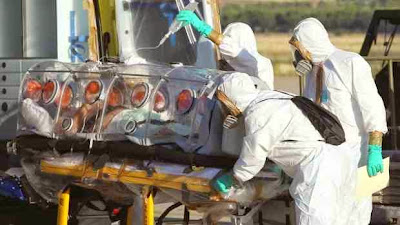signs and symptoms
The length of time between exposure to the virus and the development of symptoms of the disease is usually 2 to 21 days. PLOS
reports that the average time is 11.4 days from exposure with about one
chance in forty that a given infected person will not show symptoms
after more than 21 days.Symptoms usually begin with a sudden influenza-like stage characterized by feeling tired, fever, pain in the muscles and joints, headache, and sore throat. The fever is usually higher than 38.3 °C (100.9 °F). This is often followed by vomiting, diarrhea and abdominal pain. Next, shortness of breath and chest pain may occur, along with swelling, headaches and confusion. In about half of the cases, the skin may develop a maculopapular rash (a flat red area covered with small bumps).
In some cases, internal and external bleeding may occur. This typically begins five to seven days after the first symptoms. All infected people show some decreased blood clotting.Bleeding from mucous membranes or from sites of needle punctures has been reported in 40–50 percent of cases. This may result in the vomiting of blood, coughing up of blood or blood in stool.Bleeding into the skin may create petechiae, purpura, ecchymoses or hematomas (especially around needle injection sites). Bleeding into the whites of the eyes may also occur. Heavy bleeding is uncommon, and if it occurs, it is usually located within the gastrointestinal tract.

Recovery may begin between 7 and 14 days after the start of symptoms. Death, if it occurs, follows typically 6 to 16 days from the start of symptoms and is often due to low blood pressure from fluid loss. In general, bleeding often indicates a worse outcome, and this blood loss may result in death. People are often in a coma near the end of life. Those who survive often have ongoing muscle and joint pain, liver inflammation, and decreased hearing among other difficulties.


References
- "EBOLA RESPONSE ROADMAP SITUATION REPORT UPDATE". World Health organization. 12 November 2014. Retrieved 12 November 2014.
- "Sierra Leone: EBOLA OUTBREAK UPDATES---November 9, 2014". 9 November 2014. Retrieved 12 November 2014.
- "Ebola Hemorrhagic Fever Signs and Symptoms". CDC. 28 January 2014. Retrieved 2 August 2014.
- Charles N. Haas (14 October 2014). "On the Quarantine Period for Ebola Virus". PLoS Current Outbreaks. PLOS. doi:10.1056/NEJMoa1411100. PMID 25244186. Retrieved 13 November 2014.
- Gatherer D (August 2014). "The 2014 Ebola virus disease outbreak in West Africa". J. Gen. Virol. 95 (Pt 8): 1619–1624. doi:10.1099/vir.0.067199-0. PMID 24795448.
- Magill, Alan (2013). Hunter's tropical medicine and emerging infectious diseases. (9th ed. ed.). New York: Saunders. p. 332. ISBN 9781416043904.
- Hoenen T, Groseth A, Falzarano D, Feldmann H (May 2006). "Ebola virus: unravelling pathogenesis to combat a deadly disease". Trends in Molecular Medicine 12 (5): 206–215. doi:10.1016/j.molmed.2006.03.006. PMID 16616875.
- Simpson DIH (1977). "Marburg and Ebola virus infections: a guide for their diagnosis, management, and control" (PDF). WHO Offset Publication No. 36. p. 10f.
- "Ebola Virus, Clinical Presentation". Medscape. Retrieved 30 July 2012.
- "Appendix A: Disease-Specific Chapters". Chapter: Hemorrhagic fevers caused by: i) Ebola virus and ii) Marburg virus and iii) Other viral causes including bunyaviruses, arenaviruses, and flaviviruses. Ministry of Health and Long-Term Care. Retrieved 9 October 2014.
- Feldmann H, Geisbert TW (March 2011). "Ebola haemorrhagic fever". Lancet 377 (9768): 849–62. doi:10.1016/S0140-6736(10)60667-8. PMC 3406178. PMID 21084112.
- Fisher-Hoch SP, Platt GS, Neild GH, Southee T, Baskerville A, Raymond RT, Lloyd G, Simpson DI (November 1985). "Pathophysiology of shock and hemorrhage in a fulminating viral infection (Ebola)". J. Infect. Dis. 152 (5): 887–894. doi:10.1093/infdis/152.5.887. PMID 4045253.
- Hoenen T, Groseth A, Feldmann H (July 2012). "Current Ebola vaccines". Expert Opin Biol Ther 12 (7): 859–72. doi:10.1517/14712598.2012.685152. PMC 3422127. PMID 22559078.
- Kuhn JH, Becker S, Ebihara H, Geisbert TW, Johnson KM, Kawaoka Y, Lipkin WI, Negredo AI, Netesov SV, Nichol ST, Palacios G, Peters CJ, Tenorio A, Volchkov VE, Jahrling PB (December 2010). "Proposal for a revised taxonomy of the family Filoviridae: Classification, names of taxa and viruses, and virus abbreviations". Archives of Virology 155 (12): 2083–103. doi:10.1007/s00705-010-0814-x. PMC 3074192. PMID 21046175.
- Spickler, Anna. "Ebolavirus and Marburgvirus Infections".
- "About Ebola Virus Disease". CDC. Retrieved 18 October 2014.
- Funk DJ, Kumar A (November 2014). "Ebola virus disease: an update for anesthesiologists and intensivists". Can J Anaesth. doi:10.1007/s12630-014-0257-z. PMID 25373801.
- "Ebola (Ebola Virus Disease) Transmission". CDC. 5 November 2014. Retrieved 7 November 2014.
- Drazen, J.M.; Kanapathipillai R.; Campion E.W.; Rubin E.J.; Hammer S.M.; Morrissey S.; Baden L.R. (2014) "Ebola and Quarantine." N Engl J Med. October 27, 2014 Epub ahead of print PMID25347231
- "Q&A on Transmission, Ebola". CDC. September 2014. Retrieved 3 October 2014.
- Donald G. McNeil Jr. (3 October 2014). "Ask Well: How Does Ebola Spread? How Long Can the Virus Survive?". The New York Times. Retrieved 24 October 2014.
- "How Ebola Is Spread" (PDF). Centers for Disease Control and Prevention (CDC). November 1, 2014.
- "Transmission". CDC. 17 October 2014. Retrieved 18 October 2014.
- Chowell G, Nishiura H (October 2014). "Transmission dynamics and control of Ebola virus disease (EVD): a review". BMC Med 12 (1): 196. doi:10.1186/s12916-014-0196-0. PMC 4207625. PMID 25300956.
- "CDC Telebriefing on Ebola outbreak in West Africa". CDC. 28 July 2014. Retrieved 3 August 2014.

































I was diagnosed as HEPATITIS B carrier in 2013 with fibrosis of the
ReplyDeleteliver already present. I started on antiviral medications which
reduced the viral load initially. After a couple of years the virus
became resistant. I started on HEPATITIS B Herbal treatment from
ULTIMATE LIFE CLINIC (www.ultimatelifeclinic.com) in March, 2020. Their
treatment totally reversed the virus. I did another blood test after
the 6 months long treatment and tested negative to the virus. Amazing
treatment! This treatment is a breakthrough for all HBV carriers.